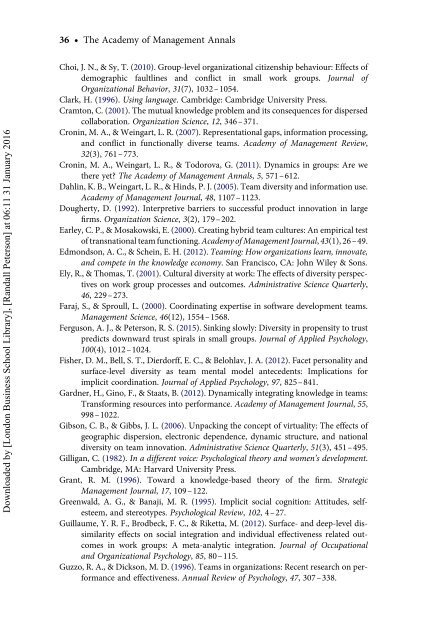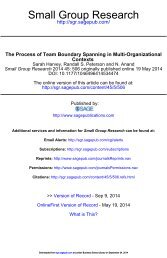A Dynamic Perspective on Diverse Teams: Moving From The Dual Process Model to A Dynamic Coordination-Based Model of Diverse Team Performance - Kannan Srikanth, Sarah Harvey & Randall Peterson
The existing literature on diverse teams suggests that diversity is both helpful to teams in making more information available and encouraging creativity and damaging to teams in reducing cohesion and information sharing. Thus the extant literature suggests that diversity within teams is a double-edged sword that leads to both positive and negative effects simultaneously.
The existing literature on diverse teams suggests that diversity is both helpful to teams in making more information available and encouraging creativity and
damaging to teams in reducing cohesion and information sharing. Thus the
extant literature suggests that diversity within teams is a double-edged sword
that leads to both positive and negative effects simultaneously.
Create successful ePaper yourself
Turn your PDF publications into a flip-book with our unique Google optimized e-Paper software.
36 † <strong>The</strong> Academy <strong>of</strong> Management Annals<br />
Downloaded by [L<strong>on</strong>d<strong>on</strong> Business School Library], [<strong>Randall</strong> Peters<strong>on</strong>] at 06:11 31 January 2016<br />
Choi, J. N., & Sy, T. (2010). Group-level organizati<strong>on</strong>al citizenship behaviour: Effects <strong>of</strong><br />
demographic faultlines and c<strong>on</strong>flict in small work groups. Journal <strong>of</strong><br />
Organizati<strong>on</strong>al Behavior, 31(7), 1032–1054.<br />
Clark, H. (1996). Using language. Cambridge: Cambridge University Press.<br />
Cramt<strong>on</strong>, C. (2001). <strong>The</strong> mutual knowledge problem and its c<strong>on</strong>sequences for dispersed<br />
collaborati<strong>on</strong>. Organizati<strong>on</strong> Science, 12, 346–371.<br />
Cr<strong>on</strong>in, M. A., & Weingart, L. R. (2007). Representati<strong>on</strong>al gaps, informati<strong>on</strong> processing,<br />
and c<strong>on</strong>flict in functi<strong>on</strong>ally diverse teams. Academy <strong>of</strong> Management Review,<br />
32(3), 761–773.<br />
Cr<strong>on</strong>in, M. A., Weingart, L. R., & Todorova, G. (2011). <str<strong>on</strong>g>Dynamic</str<strong>on</strong>g>s in groups: Are we<br />
there yet? <strong>The</strong> Academy <strong>of</strong> Management Annals, 5, 571–612.<br />
Dahlin, K. B., Weingart, L. R., & Hinds, P. J. (2005). <strong>Team</strong> diversity and informati<strong>on</strong> use.<br />
Academy <strong>of</strong> Management Journal, 48, 1107–1123.<br />
Dougherty, D. (1992). Interpretive barriers <strong>to</strong> successful product innovati<strong>on</strong> in large<br />
firms. Organizati<strong>on</strong> Science, 3(2), 179–202.<br />
Earley, C. P., & Mosakowski, E. (2000). Creating hybrid team cultures: An empirical test<br />
<strong>of</strong> transnati<strong>on</strong>al team functi<strong>on</strong>ing. Academy <strong>of</strong> Management Journal, 43(1), 26–49.<br />
Edm<strong>on</strong>ds<strong>on</strong>, A. C., & Schein, E. H. (2012). <strong>Team</strong>ing: How organizati<strong>on</strong>s learn, innovate,<br />
and compete in the knowledge ec<strong>on</strong>omy. San Francisco, CA: John Wiley & S<strong>on</strong>s.<br />
Ely, R., & Thomas, T. (2001). Cultural diversity at work: <strong>The</strong> effects <strong>of</strong> diversity perspectives<br />
<strong>on</strong> work group processes and outcomes. Administrative Science Quarterly,<br />
46, 229–273.<br />
Faraj, S., & Sproull, L. (2000). Coordinating expertise in s<strong>of</strong>tware development teams.<br />
Management Science, 46(12), 1554–1568.<br />
Fergus<strong>on</strong>, A. J., & Peters<strong>on</strong>, R. S. (2015). Sinking slowly: Diversity in propensity <strong>to</strong> trust<br />
predicts downward trust spirals in small groups. Journal <strong>of</strong> Applied Psychology,<br />
100(4), 1012–1024.<br />
Fisher, D. M., Bell, S. T., Dierdorff, E. C., & Belohlav, J. A. (2012). Facet pers<strong>on</strong>ality and<br />
surface-level diversity as team mental model antecedents: Implicati<strong>on</strong>s for<br />
implicit coordinati<strong>on</strong>. Journal <strong>of</strong> Applied Psychology, 97, 825–841.<br />
Gardner, H., Gino, F., & Staats, B. (2012). <str<strong>on</strong>g>Dynamic</str<strong>on</strong>g>ally integrating knowledge in teams:<br />
Transforming resources in<strong>to</strong> performance. Academy <strong>of</strong> Management Journal, 55,<br />
998–1022.<br />
Gibs<strong>on</strong>, C. B., & Gibbs, J. L. (2006). Unpacking the c<strong>on</strong>cept <strong>of</strong> virtuality: <strong>The</strong> effects <strong>of</strong><br />
geographic dispersi<strong>on</strong>, electr<strong>on</strong>ic dependence, dynamic structure, and nati<strong>on</strong>al<br />
diversity <strong>on</strong> team innovati<strong>on</strong>. Administrative Science Quarterly, 51(3), 451–495.<br />
Gilligan, C. (1982). In a different voice: Psychological theory and women’s development.<br />
Cambridge, MA: Harvard University Press.<br />
Grant, R. M. (1996). Toward a knowledge-based theory <strong>of</strong> the firm. Strategic<br />
Management Journal, 17, 109–122.<br />
Greenwald, A. G., & Banaji, M. R. (1995). Implicit social cogniti<strong>on</strong>: Attitudes, selfesteem,<br />
and stereotypes. Psychological Review, 102, 4–27.<br />
Guillaume, Y. R. F., Brodbeck, F. C., & Riketta, M. (2012). Surface- and deep-level dissimilarity<br />
effects <strong>on</strong> social integrati<strong>on</strong> and individual effectiveness related outcomes<br />
in work groups: A meta-analytic integrati<strong>on</strong>. Journal <strong>of</strong> Occupati<strong>on</strong>al<br />
and Organizati<strong>on</strong>al Psychology, 85, 80–115.<br />
Guzzo, R. A., & Dicks<strong>on</strong>, M. D. (1996). <strong><strong>Team</strong>s</strong> in organizati<strong>on</strong>s: Recent research <strong>on</strong> performance<br />
and effectiveness. Annual Review <strong>of</strong> Psychology, 47, 307–338.
















